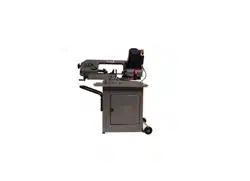Loading ...
Loading ...
Loading ...

15
Figure 7-10
8.0 Operation
The HBS-56MVS is equipped with a motor driver
containing a voltage feedback device to provide
consistent torque during operation.
The saw is also provided with an overload protection
device to prevent overheating of the motor. If saw
shuts off because of overload, allow to cool a few
minutes, then restart.
8.1 Blade selection
The saw is provided with a blade that is adequate
for a variety of cut-off jobs on a variety of common
materials.
See Table 3 for recommended speeds for various
materials. These selections, while appropriate for
many shop cutting needs, do not encompass the
wide variety of blades of special configuration (tooth
pitch and set) and special alloys for cutting unusual
or exotic materials.
Material
Speed
(SFPM)*
Hardened Ferrous
80-130
Ferrous
130-180
Non-ferrous, Plastic, Wood
180-230
*SFPM = surface feet per minute
Table 3: Speed recommendations
A coarse blade could be used for a solid steel bar
but a finer tooth blade would be used on a thin-wall
tube. In general, the blade choice is determined by
the thickness of the material; the thinner the
material, the finer the tooth pitch.
General rule for band saw blade speed: The
harder the material being cut, the slower the
blade speed.
A minimum of three teeth should be on the work
piece at all times for proper cutting. The blade and
workpiece can be damaged if the teeth are so far
apart that they straddle the workpiece.
For very high production on cutting of special
materials, or to work hard-to-cut materials such as
stainless steel, tool steel, or titanium, ask your
industrial distributor for more specific blade
recommendations. Also, the supplier who provides
the workpiece material should be prepared to
provide specific instructions regarding the best
blade (and coolant or cutting fluid, if needed) for the
material and shape supplied.
Use of a cutting oil is recommended when cutting at
higher blade speeds.
8.2 Blade break-in
New blades are very sharp and therefore have a
tooth geometry which is easily damaged if a careful
break-in procedure is not followed. Consult the
blade manufacturer’s literature for break-in of
specific blades on specific materials. However, the
following procedure will be adequate for break-in of
JET-supplied blades on lower alloy ferrous
materials.
1. Clamp a round section workpiece in the vise.
The workpiece should be 2 inches or larger in
diameter.
2. Set the saw on low speed. Start the cut with a
very light feed rate.
3. When the saw has completed 1/3 of the cut,
increase feed rate slightly and allow saw to
complete the cut.
4. Keep the same hydraulic cylinder setting and
begin a second cut on the same or similar
workpiece.
5. When blade has completed about 1/3 of cut,
increase feed rate. Watch chip formation until
cutting is at its most efficient rate and allow saw
to complete the cut (see sect. 8.4, Evaluating
cutting efficiency).
6. The blade is now ready for regular service.
8.3 General operating procedure
1. Raise bow and secure in position using prop.
Always secure bow in
raised position with prop before loading
material. Never start a cut with blade
contacting workpiece.
Loading ...
Loading ...
Loading ...
